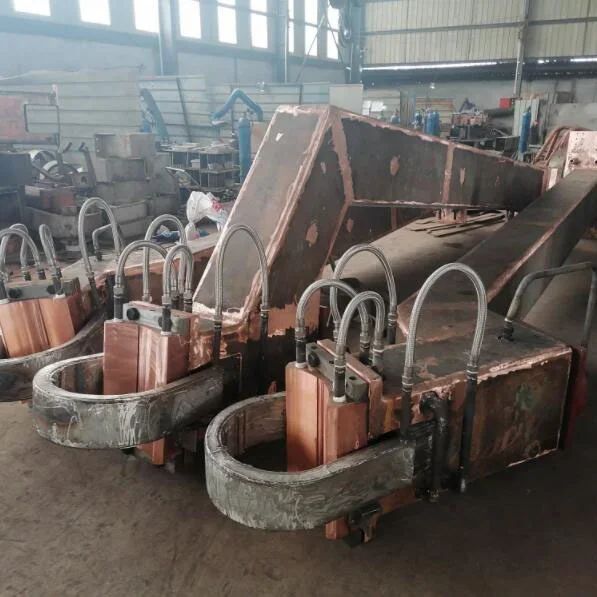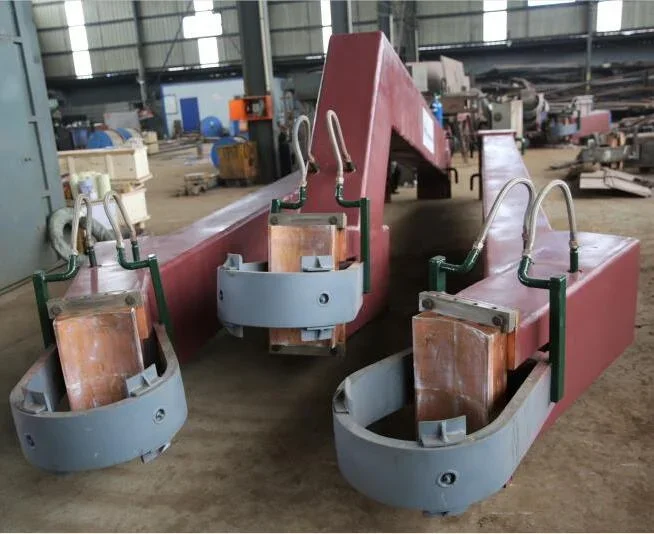In the realm of steel production and metallurgical industries, the efficiency and safety of furnace operations are paramount. One critical component that plays a significant role in these processes is the Power Conducting Arm, specifically designed for Electric Arc Furnace (EAF) and other related applications. This blog delves into the functional overview of the Power Conducting Arm, examining its design, materials, features, and applications in various industries.
Design and Materials
The Power Conducting Arm, also known as the clamping arm for EAF Industrial Electrode Arm, is a sophisticated piece of equipment that facilitates the conduction of electrical power to the furnace. It is available in various types, including those suitable for Electric Arc Furnaces, EAF LF, Ladle Furnaces, and CURRENT CONDUCTING ELECTRODE ARM Assembly. The primary materials used in its construction are copper and steel, with copper being employed for its excellent electrical conductivity and heat dissipation properties, while steel provides structural strength and durability.

Key Features
Clamp Ring Accessibility and Safety: The clamping device of the Power Conducting Arm is designed for easy accessibility, allowing for routine inspections and repairs. In the event of electrode breakage or arcing, the clamp ring can be swiftly removed to mitigate further damage.
Copper Clad Explosion Plate: To ensure the integrity of the material and prevent lamination, copper clad explosion plates are used in the construction of the arms. This feature enhances the safety and reliability of the Power Conducting Arm under high electrical stress.
Rectangular Welded Box Design: The arms are crafted with a rectangular welded box type design, which not only provides structural rigidity but also allows for copper plating in areas where the main current flows. This design ensures efficient current conduction and minimizes energy loss.
Forged Copper Terminal Connections: The terminal connections for the cables are made from forged copper sections, which can accept current cables without the need for modifications. This feature simplifies the installation process and reduces downtime.
Internal Water Cooling: The entire arm body is water cooled from the inside, which is crucial for managing the heat generated during high-current operations. This cooling system helps maintain the arm's structural integrity and prolongs its service life.
Protection of Critical Components: All critical components on the electrode arms, including water piping for spray rings and hydraulic lines for the clamping mechanism, are protected within copper clad steel. This protection ensures the longevity and reliability of these components under harsh operating conditions.
Electrode Shoe Design: The electrode shoe is designed for a flat connection to the arm body, facilitating easy replacement and repairability. This design also simplifies the alignment process and reduces costs associated with maintenance.
Contact Shoe with Water Cooling Channels: The contact shoe, made of forged copper, features bored water cooling channels to achieve efficient heat transfer. A flanged water connection maintains a steady water supply, ensuring the contact shoe remains cool during operation.
Applications
The Power Conducting Arm finds widespread application across various industries that rely on furnace operations. Some of the key industries include:
Steel Plants: In steel plants, the Power Conducting Arm is used in EAF, LF, and other furnace types. It plays a crucial role in the efficient and safe conduction of electricity, which is vital for melting and refining steel.
Ferro Alloy Plants: Ferro alloy plants utilize the Power Conducting Arm for their furnaces, which are essential for producing various alloys used in steelmaking and other industries.
Calcium Carbide Plants: Calcium carbide production requires high temperatures and controlled electrical conduction, making the Power Conducting Arm an indispensable component in these plants.
Furnace Manufacturers: Furnace manufacturers integrate Power Conducting Arms into their designs to ensure that their products meet the high standards of safety, efficiency, and reliability demanded by the market.

Innovations and Advantages
The Power Conducting Arm represents a significant advancement in furnace technology. Its innovative design and material choices offer several advantages:
Enhanced Safety: The copper clad explosion plate and internal water cooling systems significantly reduce the risk of electrical hazards and overheating.
Improved Efficiency: The efficient conduction of electricity and heat management contribute to higher furnace efficiency, leading to cost savings and reduced energy consumption.
Durability and Longevity: The use of high-quality materials and robust design ensure that the Power Conducting Arm can withstand the rigors of continuous operation in harsh environments.
Ease of Maintenance: The accessibility of the clamping device and the flat connection design of the electrode shoe simplify maintenance procedures, reducing downtime and associated costs.
Versatility: The Power Conducting Arm's design accommodates various furnace types and applications, making it a versatile solution for different industries.
Conclusion
The Power Conducting Arm is a critical component in the steel production and metallurgical industries, offering a blend of safety, efficiency, and durability. Its innovative design and features make it an essential tool for modern furnace operations. As industries continue to evolve and demand higher standards of performance, the Power Conducting Arm stands as a testament to the importance of technological advancements in ensuring the success and sustainability of furnace operations.
Power Conducting Arm: Enhancing Efficiency in Industrial Furnaces
